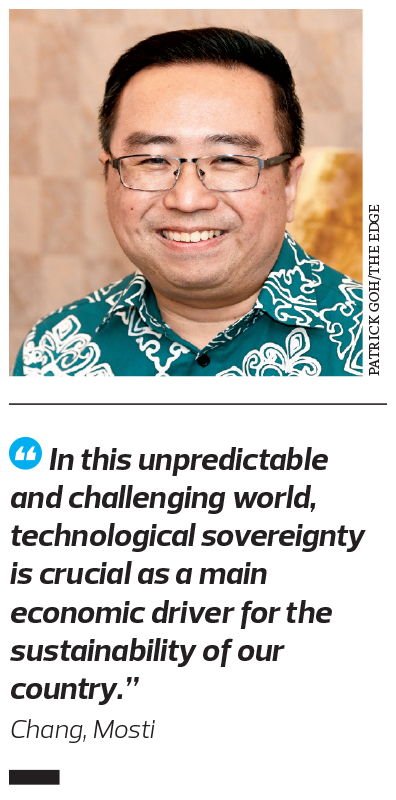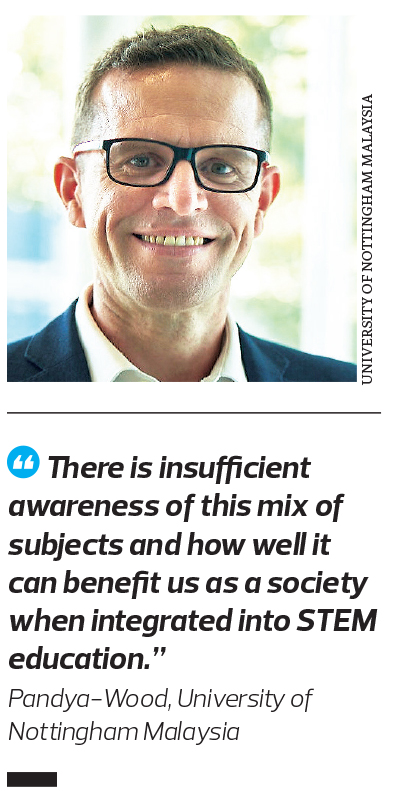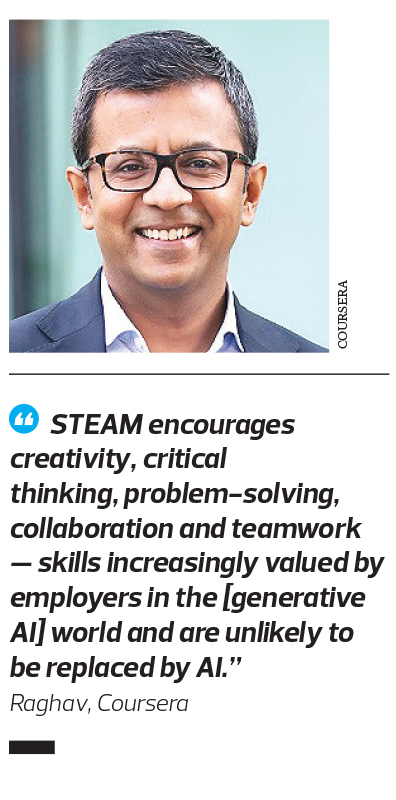
This article first appeared in Digital Edge, The Edge Malaysia Weekly on December 9, 2024 - December 15, 2024
Since its introduction in Malaysia’s 2013 education blueprint, STEM — science, technology, engineering and mathematics — has been the cornerstone of the nation’s academic priorities.
The objective was clear, to equip students with the technical skills demanded by a tech-centric economy. Yet, in a paradox that feels almost inevitable, the jobs flooding the market increasingly prize qualities that STEM alone doesn’t teach — communication, critical thinking and creative problem-solving.
These are the hallmarks of the arts and social sciences, fields that some argue should not compete with STEM but converge with it, forming STEAM, a model that seeks to bridge the technical with the human.
“As the job market evolves, the ability to think in inventive ways and solve complex, real-world problems becomes more crucial … STEAM education will help to equip students with the necessary essential and technical skills needed to work collaboratively and efficiently in professional environments,” says Dr Jason Pandya-Wood, dean of the Faculty of Arts and Social Sciences at the University of Nottingham Malaysia Campus.
While the arts and the teaching of soft skills have their place in the education system, STEM remains the focal point, driven by the Ministry of Science, Technology and Innovation’s (Mosti) ambition to position Malaysia as a high-tech nation in six years.
Pandya-Wood says STEAM, which integrates the arts into STEM, has yet to gain widespread traction due to the significant investment and collective effort it demands from stakeholders across the education sector. He stresses that Malaysia’s current STEM curriculum lacks the necessary framework for broad-scale adoption of STEAM.
From a governance standpoint, Mosti is prioritising the development of a robust talent pool to ensure Malaysia remains competitive on the global stage, particularly as artificial intelligence (AI) and other technological advancements continue to redefine industries. This focus highlights the pressing need to build a workforce capable of driving sustainable growth in a technology-driven era.
“In this unpredictable and challenging world, technological sovereignty is crucial as a main economic driver for the sustainability of our country. In the National Science, Technology and Innovation Policy 2021-2030, we have formulated an aspiration to become a high-tech nation by 2030,” says Minister of Science, Technology and Innovation Chang Lih Kang.
Mosti envisions transforming Malaysia from a technology consumer to a creator, with an emphasis on nurturing local talent in science, technology and innovation (STI). This makes STEM education indispensable as a foundation for developing such expertise. Additionally, STI talent must be equipped with the flexibility and knowledge required to navigate and excel in an ever-changing and fast-paced global market.
Citing the World Economic Forum’s Future of Jobs 2023 report, Chang expressed concern about projections that 25% of jobs in Malaysia will undergo significant changes by 2027, with 71% of new job opportunities driven by the adoption of emerging technologies. “Adding this on top of [the fact that] Malaysia’s digital technology industry is projected to make up 22.6% of GDP (gross domestic product) in 2024, it is clear that there is a strong need for STEM education,” he says.
Educators argue that excluding the arts from STEM is a missed opportunity, stressing that integrating the two is essential to avoid compartmentalising education into rigid silos.
“There is insufficient awareness of this mix of subjects and how well it can benefit us as a society when integrated into STEM education,” says Pandya-Wood.
Arts remain important in education
Chang highlights that a STEM-focused education provides foundational principles crucial for navigating the future. It fosters numerical understanding through mathematics and explores design and structure in engineering and technology — concepts he describes as “future-proof” because of their continuous application in everyday life.
However, the minister acknowledges the importance of the arts and the growing demand for soft skills in today’s job market. He noted that employers often face challenges with researchers and technical employees who struggle to effectively articulate their ideas, underscoring the need for a more holistic approach to education.
“STEM may educate our talents to be precisely technical but lacking in people-centric knowledge,” says Chang. This has led to a gap between “the lab and the market”, he adds.
“Arts education may fill this gap by bringing the technical mindset closer to ordinary life through people skills like business communication, including negotiation, active listening and problem solving,” he says.
Although the arts are not formally integrated into Malaysia’s STEM curriculum, they still play a significant role in the broader education system.
“Both STEM and STEAM are important … the arts are part and parcel of our education system. Therefore, learning STEM either through formal or informal channels includes learning the arts,” Chang asserts.
He points to subjects like languages, visual arts, music, moral education and Islamic studies as ways the arts find a place in the education system. While the overall approach remains STEM-centric, the presence of the arts still influences students’ learning experiences, he says.
“The arts are added to stimulate creative thinking that will trigger interdisciplinary collaboration in our daily lives. Our education system has embedded arts elements at school through visual arts and music education, as well as language, literature, religious and moral education,” he says.
Chang highlights that Mosti runs various STEM enculturation programmes, such as National Science Week, Techlympics and STEM Camps, aimed at schoolchildren and higher education students. These initiatives not only foster an interest in STEM but also help students develop essential soft skills like communication, critical thinking and entrepreneurship.
However, he acknowledges that the arts are predominantly emphasised at the primary and secondary school levels. In tertiary education, the arts are often relegated to electives, specialised programmes or extracurricular activities, limiting their integration into the core curriculum.
Pandya-Wood suggests that such classes persist even at the tertiary level, either as standalone classes or directly integrated into existing STEM classes.
“Arts can be a standalone subject that introduces essential skills such as creativity and cultural awareness. But I also believe that the arts are a great supplement to existing STEM subjects. This way, it doesn’t just shape essential skills but also enriches the understanding of the student experience and provides a deeper appreciation for learning and innovative problem-solving,” he says.
Pandya-Wood admits that in a very technical world STEM takes priority, but believes that the arts can help STEM students to better understand the subject matter and bring positive changes.
“Arts are often undervalued as compared to STEM fields, which affects their inclusion in the educational environment in Malaysia. I believe that a steady cultural shift would be beneficial to help recognise the importance of interdisciplinary learning,” he says.
Mosti’s view does align with the idea of incorporating key soft skills into the curriculum and teaching methods in STEM, believing that STEM students are capable enough.
“A purely STEM education can accommodate the growing importance of critical thinking, communication and leadership skills by incorporating these elements into the curriculum and teaching approaches,” says Chang.
In addition, he says that in terms of cognitive and other intelligent factors, STEM students in general are highly capable of dealing with non-science or social science subjects. Therefore, integration of STEM education with any arts subject is feasible to be implemented.
A need to develop soft skills
“STEAM encourages creativity, critical thinking, problem-solving, collaboration and teamwork — skills increasingly valued by employers in the [generative AI] world and are unlikely to be replaced by AI,” says Raghav Gupta, managing director for Asia-Pacific at Coursera.
He notes that Malaysians’ interest in tech, leadership, AI, data science and communication has been on the rise, with STEAM education needed to bridge the gap between education and industry needs in preparing graduates for in-demand jobs.
“This is reflected in our partnerships with Malaysian institutions like Brickfields Asia College, the first to adopt Coursera for Campus, integrating it into various programmes to produce well-rounded graduates,” says Raghav.
Pandya-Wood contends that in today’s job market, soft skills have become so critical for graduates that they are arguably more important than technical expertise.
“In survey after survey, we find that employers prioritise several core skills built around analytical thinking, creativity, resilience, teamwork and so on — often seen as more important than technical skills alone … we should probably rename ‘soft skills’ as ‘essential skills’,” he points out.
Using those in the arts to attract more to STEM
In March, Prime Minister Datuk Seri Anwar Ibrahim noted a low interest in the STEM stream of education among Malaysian students. Possible reasons from experts tended to lean towards weaker foundations in school, perceiving STEM subjects as difficult or the perception that they are less interesting and engaging compared to more creative subjects like the arts.
Despite a decrease in interest in pure STEM subjects, online education provider Coursera is seeing year-on-year growth in course enrolments in both the arts and STEM-related courses among Malaysians.
“We have observed a strong demand for both arts-related and STEM courses among Malaysian learners. There has been a 41% year-on-year growth in course enrolments, with a notable 44% growth in STEM courses and 37% growth in non-STEM courses,” says Raghav.
This was shown in the most popular courses in 2023, showing a mix of various arts and STEM courses, he adds.
“The top 10 courses among Malaysian Coursera for Campus learners in 2023 reflect this diverse demand, featuring a well-rounded mix of technology, data science, business, arts and personal development skills,” says Raghav.
Popular courses included Introduction to English Common Law and Citizenship and the Rule of Law from the University of London, Developing Innovative Ideas for New Companies from the University of Maryland and Managing Responsibly: Practising Sustainability.
These were also complemented by industry-focused courses like Google’s Foundations of Project Management, Foundations of Digital Marketing and E-commerce as well as DeepLearning.AI’s AI For Everyone course.
“We foresee a growing convergence of tech and arts, aligning with efforts by the Ministry of Higher Education and the Malaysian Qualifications Authority … [which] allows 30% of credits to be earned online, paving the way for collaboration between campuses, industry and learning institutions to introduce the latest skills to students through a multidisciplinary approach,” says Raghav.
For Pandya-Wood, an institutional approach of formally incorporating the arts into STEM could be the answer in renewing interest in the curriculum. “The incorporation of the arts, while making STEM subjects more artistic for current students in the relevant fields, can potentially invite other students to take interest in it as well.”
He explains that broadening the pool to foster a more inclusive and accessible educational environment can attract more potential STEM students, dipping into untapped potential students who would otherwise not be interested in STEM.
For example, the University of Nottingham Malaysia hosted a STEAM Carnival in April which resonated strongly with students. The event featured interactive STEM course booths designed with a creative twist, encouraging students with artistic inclinations to explore pathways in STEM-related fields.
Save by subscribing to us for your print and/or digital copy.
P/S: The Edge is also available on Apple's App Store and Android's Google Play.
- Short selling suspended for 18 counters amid market sell-off
- Market plunge drags FBM KLCI down over 5%, as East Asian markets sink on trade war concerns
- Are investors cutting losses on Genting Malaysia?
- China has already trade-war-proofed its economy
- US reciprocal tariffs to negatively impact CPO prices, may prompt earnings cut — CIMB Securities
- JPMorgan CEO Dimon warns tariffs could slow US growth, fuel inflation
- 1MDB-Tanore: Retired police officer confirms Najib benefitted from 1MDB funds, key management didn't
- Short selling suspended for 18 counters amid market sell-off
- Malaysia Smelting Corp faces tin production disruption from gas supply issues, but expects no major impact on FY2025 earnings
- Philippines mulls cutting tariffs on US products, says trade chief



